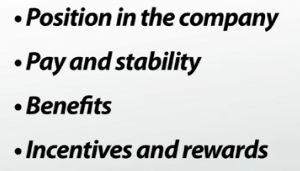Behavioral Management Theory: Understanding Employee Behavior & Motivation - Quiz
Choose your answer and write the correct one down. Then click HERE for the answers to this quiz.
NOTE: The transcript from the video is listed below the quiz for your reference.
1. Elton Mayo observed
- all workers in the telephone wiring company.
- a control group of workers in the telephone wiring company.
- managers in a telephone writing company.
- policies in a telephone writing company.
- how to weave wires together.
2. Classical Management focuses on
- human relations - not productivity.
- high productivity and human relations.
- low productivity and human relations.
- workers are machines solely working toward production goals.
- building strong communication and relationships.
3. Behavioral Management is
- focused on leader-employee relations.
- focused on productivity only.
- changes in worker behavior so the workers accept orders to work better.
- changes in productivity schedules to meet worker capability.
- a set of procedures and rules to work by.
4. Motivation to work harder comes from
- intrinsic factors alone.
- intrinsic and external factors.
- external factors only.
- a set of rules about how to be motivated.
- manager directives to want to be at work.
5. High productivity can result from
- good communication.
- benefits.
- rewards and incentives.
- good working conditions.
- all answer choices are correct.
Behavioral management theory was developed in response to the need to account for employee behavior and motivation. The shift moved management from a production-orientation (classical leadership theory) to a leadership style focused on the workers' human need for work-related satisfaction and good working conditions.
A Shift in Theories
Long before theorists started writing about employee satisfaction and good working conditions, management considered classical leadership, with its sole interest in high production and efficiency, to be the most important to an organization's success. Later, it was concern for worker satisfaction and good working conditions that formed the foundation for behavioral management theory.
Behavioral management theory relies on the notion that managers will better understand the human aspect to workers and treat employees as important assets to achieve goals. Management taking a special interest in workers makes them feel like part of a special group.
 |
As time went on, thinking shifted, and management started looking at employee satisfaction and working conditions as a way to increase productivity. Theorists like Elton Mayo and others studied employee productivity under different conditions to determine a connection.
Mayo's Hawthorne experiment provides a good example of this. In the Hawthorne experiment, a group of telephone line workers were separated and observed working in a private room. During their workday, the group members were given special privileges, like freedom to leave their workstations, changes in pay rates, and even company-sponsored lunch. What they discovered was the control group produced more than the other employees. The rationale for this increased production was that the group felt that management was interested in their well-being.
This began the human relations movement for management. If all management had to do was spend time, express interest in workers' personal well-being, and reward them for a job well done, workers would feel motivation to work harder. In fact, behavior towards work would be positive.
Behavior and Motivation
Let's see how behavioral management theory works in a modern day telephone line company. Total Telephone Line Company workers perform the monotonous job of weaving telephone lines together. Managers know the work is boring and often results in poor productivity and absenteeism.
 |
Percy oversees the workers as they weave away, making sure each set of wires is perfect. Workers like Lucy and Marcy chit-chat during most of their shift, getting very little done. Daphne daydreams about working as a fashion designer and uses much of her workday sketching haute couture on lunch napkins.
Percy used to yell at the ladies and banish them to silence. Daphne even had her pencils taken away from her on several occasions. But productivity did not increase. In fact, it decreased. Percy knew she had to try something new. She had a tough challenge. She is responsible for high productivity. After all, Total Telephone Wire is profit motivated.
Percy researched ways to improve productivity and came across a book on behavioral management theory. She found that a greater concern for employee needs leads to higher satisfaction levels and better overall performance, which leads to behavioral changes in their response to work.
 |
Percy changed the way she managed the ladies. She asked questions about their work environment. She even took suggestions about how they can perform their job more efficiently. What Percy discovered is that the more she connected with the ladies, the more motivated they were to perform and do a good job. This changed their behavior towards Percy's drilling orders, and it increased their productivity.
Behavior is defined as the way a person conducts themselves towards others. When workers are treated as humans rather than machines, they respond to their particular work situation in a positive way - by increasing individual productivity.
Percy read the work of theorists who described the things that inspire people to go to work. What she learned was astonishing. While salary is important, it is not the only important consideration. Workers had more intrinsic motives for working, like:
- Self-fulfillment
- Autonomy and empowerment
- Social status
- Personal relationships with co-workers
Motivation is the internal process that directs enduring behavior. For Percy, this means workers are often inspired from within, not always as a result of external factors, to work. Motivation comes from many factors:
- Position in the company
- Pay and stability
- Benefits
- Incentives and rewards
- Interesting work assignments
- Common beliefs and values
Percy started an incentive program. Telephone line workers would receive extra money for high production. She also offered benefits like tuition reimbursement so Daphne could attend fashion school.
 |
These factors, in combination with things like:
- Positive feedback and appraisals
- Good communication
- Good working conditions
- Involvement with decision-making
- Common goal setting
- Group processes
- Good leader-worker relations
led to a more productive and satisfied set of workers because behavioral management theory relies so heavily on behavioral and motivational factors.
Lesson Summary
In summary, behavioral management theory shifted management's belief that workers were like machines and productivity was the result of management's drive for profits alone.
Theorists like Elton Mayo and others began studying the motives and behaviors of employees to find out what motivates employees to work harder. Observing a control group as they worked and manipulating variables like break times revealed that when workers feel a sense of autonomy over their work, their productivity increases. This shocking revelation instigated the need to re-think the leader-worker relationship. This gave way to the notion that workers are intrinsically motivated to work. When work is self-fulfilling and brings a high degree of satisfaction, productivity is high.
Managers shifted focus from mere production and began building strong relationships with workers. To do this, managers provided employees with positive feedback and appraisals, good working conditions, involvement in decision-making, and good communication. Ultimately, managers who show concern for workers have high productivity because workers experience increased satisfaction.